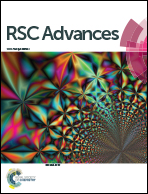Facile synthesis of Gd(iii) metallosurfactant-functionalized carbon nanodots with high relaxivity as bimodal imaging probes†
Abstract
Fluorescence and magnetic resonance (MR) dual-modal imaging contrast agents were prepared by the self-assembly of carbon nanodots (CDs) and gadolinium(III)-containing metallosurfactants (MS). This self-assembly process, driven by facile ionic interaction between MS and CDs, provides a new method for the preparation of dual-modal contrast agents. The obtained assemblies (MS–CDs) were investigated by various characterization techniques. Zeta potential measurement validated the driving force for the self-assembly. Transmission electron microscopy (TEM), dynamic light scattering (DLS) and Fourier transform infrared spectroscopy (FTIR) confirmed the formation of the aggregates, MS–CDs. The relation between zeta potential and particle size revealed the formation process of MS–CDs assemblies. It was noteworthy that the MS–CDs assemblies exhibited high relaxivity (r1 = 19.73 mM−1 s−1, at 1.5 T) for MR imaging, which was more than fourfold that of commercial agents. The stability of the MS–CDs was evaluated by relaxation study and aggregation behaviour in phosphate buffer solution (PBS). Furthermore, good photoluminescence and low cytotoxicity were observed in model cell lines, suggesting that MS–CDs have great potential for bioimaging applications.



 Please wait while we load your content...
Please wait while we load your content...